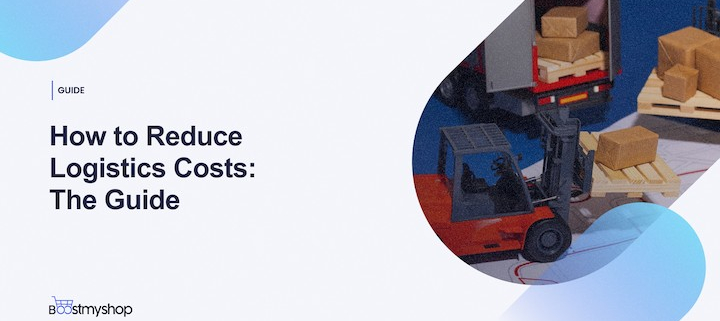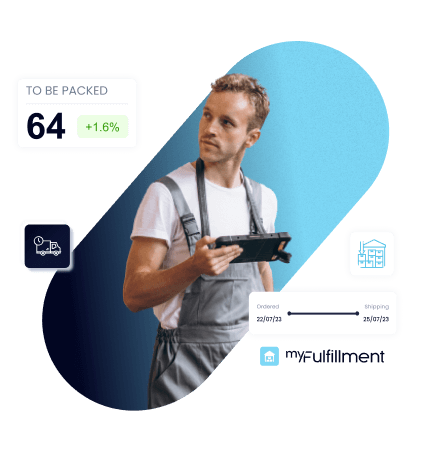How to Reduce Logistics Costs: The Guide
Introduction
In today’s competitive ecommerce landscape, optimizing logistics costs has become paramount for companies seeking sustainable growth and profitability. Implementing cost-reduction strategies helps businesses streamline operations and gain a competitive edge in the market. This article explores various essential methods to reduce logistics costs and highlights the significant benefits of doing so.
Analyzing Current Logistics Costs/Expenses
Conducting a cost analysis is vital for initiating cost reduction. Examining the entire supply chain, including transportation, warehousing, inventory, and handling costs, helps identify areas of excessive spending and cost drivers.
Identifying specific cost drivers and high-expenditure areas is crucial. These drivers may include inefficient inventory management, suboptimal transportation routes, and excessive expenses. Targeted cost reduction strategies can be developed based on these findings.
Assessing the impact of logistics costs on the overall business is essential for decision-makers. Evaluating their effect on profitability, cash flow, customer satisfaction, and competitiveness provides a comprehensive understanding of the need to reduce these costs. This assessment serves as motivation and justification for implementing necessary changes.
Streamlining Supply Chain Operations to Reduce Logistic Costs
Optimizing inventory management is crucial for reducing logistics costs. Techniques like demand forecasting, safety stock optimization, and efficient order management can yield significant savings. By avoiding excess inventory, minimizing stockouts, and optimizing reorder points, businesses achieve the right balance between inventory levels and costs.
Implementing a Just-in-Time (JIT) inventory system reduces holding costs. JIT ensures goods and materials arrive just in time for production, minimizing the need for extensive warehousing and unnecessary inventory-carrying costs.
Improving demand forecasting accuracy is essential. Leveraging historical data, market trends, and advanced analytics tools enhances accuracy. Accurate forecasting enables better production planning, optimized transportation routes, and reduced carrying costs.
Enhancing Transportation Efficiency
Choosing cost-effective transportation modes is crucial for reducing logistics expenses. Evaluating and selecting the appropriate mode based on factors like distance, urgency, and cargo characteristics can lead to substantial savings.
Utilizing intermodal transportation, which combines multiple modes of transport within a single journey, offers cost-saving opportunities. Integrating trucking, rail, and maritime shipping optimizes routes, reduces fuel consumption, and minimizes handling and storage costs.
Collaborating with transportation partners is essential for negotiating favorable rates and volume discounts. Consolidating shipments or entering long-term contracts with carriers enhances transportation efficiency and reduces logistics costs. Strong partnerships foster mutually beneficial relationships.
Warehouse and Distribution Center Optimization
Implementing layout and space utilization improvements is crucial for reducing logistics costs. By optimizing storage arrangements, equipment placement, and workflow, businesses can maximize space utilization, minimize travel distances, and improve operational efficiency. This optimization leads to reduced labor costs and improved productivity.
Utilizing automation and technology is a game-changer for warehouse operations. Robotic systems, conveyor belts, barcode scanning, and inventory management software streamline processes, reduce errors, and enhance efficiency. Automation optimizes labor utilization, reduces costs, and improves order fulfillment speed.
Implementing lean principles, like 5S methodology and continuous improvement, reduces waste and improves productivity. By eliminating waste, minimizing movement, and implementing efficient workflows, businesses enhance productivity and reduce costs. Lean thinking encourages employees at all levels to identify and eliminate non-value-added activities, driving further cost reduction.
Effective Route Planning and Optimization
Utilizing route optimization software and tools is critical for efficient transportation management. Advanced software and tools optimize routes, considering factors like distance, traffic, fuel consumption, and time constraints. This minimizes costs, reduces delivery time, and enhances operational efficiency.
Reducing empty backhauls and optimizing load capacity is essential. Strategic route planning and collaboration minimize empty backhauls. Efficiently consolidating shipments optimizes load capacity, reducing costs and enhancing resource utilization.
Incorporating real-time traffic and weather data improves routing decisions. Considering road congestion, weather conditions, and other factors in real-time optimizes routes, reduces delays, and minimizes fuel consumption. This proactive approach reduces costs while improving delivery reliability.
Negotiating Favorable Contracts with Suppliers and Carriers
Building strong relationships with suppliers and carriers is crucial for reducing logistics costs. Through open communication, trust, and collaboration, businesses can negotiate favourable pricing and conditions. Strong partnerships with reliable and cost-efficient partners contribute to cost reduction and supply chain efficiency.
Effective negotiation skills are essential for securing better pricing and terms with suppliers and carriers. By researching market rates, analyzing competitors, and leveraging volume commitments, businesses can enhance their bargaining power. Successful negotiations lead to cost savings, improved service levels, and long-term partnerships.
Long-term contracts provide stability and predictability in logistics costs. By entering into mutually beneficial agreements, businesses can secure fixed or discounted rates, ensuring cost stability over an extended period. This stability allows for better budgeting and financial planning, minimizing the risk of cost fluctuations.
Implementing Inventory Management Techniques
Adopting a centralized inventory control system provides visibility and control over stock levels. Inventory management software optimizes levels, prevents stockouts, and reduces carrying costs. A centralized approach enhances coordination and collaboration among stakeholders, improving inventory management.
Implementing ABC analysis categorizes inventory based on value and importance. Classifying items into high, medium, and low-value categories prioritizes management efforts. This ensures attention to high-value items and efficient management of low-value items, reducing costs.
Reducing excess and obsolete inventory requires effective planning. Techniques like demand forecasting and proactive communication with suppliers and customers minimize excess accumulation. Product lifecycle management and promotions mitigate obsolescence risks.
Leveraging Technology for Logistics Cost Reduction
Implementing an order management system like Boostmyshop myFulfillment offers numerous benefits in reducing logistics costs. Firstly, it enables centralized order processing and tracking, eliminating inefficiencies and reducing errors associated with manual handling. By automating order management workflows, businesses can streamline operations, minimize order processing time, and optimize resource allocation, thereby reducing labour costs. Additionally, an order management system provides real-time visibility into inventory levels, allowing for improved inventory planning and reducing holding costs. With better inventory control, businesses can avoid stockouts and overstocking, leading to lower carrying and storage expenses. Furthermore, the system facilitates seamless integration with shipping carriers, enabling businesses to compare rates, choose the most cost-effective shipping options, and optimize shipping costs. Ultimately, employing an order management system enhances operational efficiency, reduces costs associated with manual processes and inventory management, and improves overall logistics performance.
Implementing a robust Transportation Management System (TMS) (E.g., UPS, DHL) or Shipping management platform(E.g., Ship theory) optimizes transportation operations. A comprehensive TMS enables route planning, real-time shipment tracking, and data consolidation for analysis. This technology-driven approach enhances efficiency, reduces costs, and improves supply chain visibility.
Utilizing data analytics identifies inefficiencies and trends. By leveraging data from transportation, warehousing, and inventory, businesses gain insights for performance measurement, optimization, and cost reduction.
Implementing real-time tracking and visibility solutions monitors shipments in real-time. Technologies like GPS tracking, RFID, and IoT devices improve supply chain visibility, on-time delivery rates, and reduce delays. Real-time insights empower proactive issue resolution and logistics optimization.
Collaborating with Supply Chain Partners
Forming strategic partnerships with suppliers and distributors optimizes logistics costs. Businesses align goals and share information to identify cost-saving opportunities throughout the supply chain. Collaborative relationships facilitate joint procurement, co-managed inventory, and synchronized production planning.
Implementing collaborative planning, forecasting, and replenishment (CPFR) promotes coordination and synchronization among companies. Collaborating on demand forecasting, production planning, and replenishment optimizes inventory levels, reduces stockouts, and minimizes logistics costs. CPFR ensures a shared focus on cost reduction and efficiency among partners.
Sharing resources and leveraging economies of scale reduces logistics costs. Businesses pool warehousing, transportation, or order fulfillment facilities with others for cost efficiencies through shared infrastructure and reduced overheads. Collaborative efforts enable the negotiation of volume discounts with service providers, enhancing cost-reduction opportunities.
Continuous Improvement and Logistics Costs Monitoring
Establishing logistics cost-specific KPIs is vital for effective monitoring. KPIs like cost per unit shipped or transportation cost ratio provide measurable targets. Regularly monitoring these metrics helps identify trends and make informed decisions.
Regular audits and assessments identify areas for improvement. Auditing logistics processes and contracts uncover inefficiencies and cost-saving opportunities. Corrective actions streamline operations and enhance efficiency.
Encouraging employee suggestions drives cost reduction. Incentivizing ideas and involving employees fosters ownership and continuous improvement.
Conclusion
Reducing logistics costs is crucial for businesses to achieve operational excellence and financial success. To achieve this, businesses should streamline supply chain operations, improve transportation efficiency, optimize warehouse and distribution centres, and leverage technology. Collaborating with supply chain partners, monitoring costs, and fostering a culture of improvement also contribute to sustained cost reduction. Embracing these methods allows companies to unlock savings, enhance their competitive position, and achieve long-term success in logistics.



